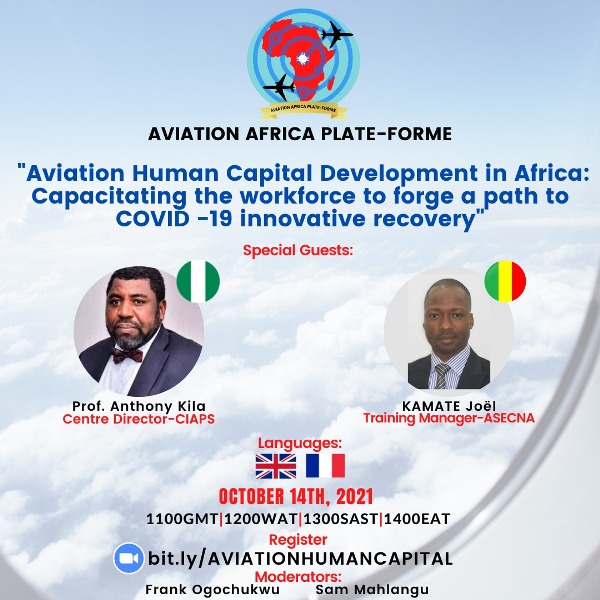Human Capital Planning Capacity Will Determine Africa’s Aviation Future, Players Say

“The capacity of the aviation industry to plan for its human capital will determine the sector’s future.”
This is part of the contents of a communique issued at the end of Aviation Africa Plate-Forme, a webinar directed by Engr. Ifeanyi Ogochukwu and B.S Mahlangu on October 14, 2021 with the theme, “Aviation Human Capital Development In Africa: Capacitating The Workforce Is To Forge A Path To Covid19 Innovative Recovery.”
Key Speakers at the event were Prof. Anthony Kila, Director, Centre for International & Advanced Professional Studies and Mr. Kamate Joel, Training Manager, ASECNA with an industry contribution from Maureen Isika, President of Kenya Air Traffic Controllers Association; Capt. Kofi Atiemo, Boeing 777 Commander, and Renaud Katel Kinzonzi Maleka, ATSEP Systems Engineer, ASECNA.
Other resolutions reached at the end of the event were that: “The COVID-19 experience has forced aviation and other sectors to embrace technology more than ever, restricted movement and travels and amplified health issues in the aviation industry and training is needed to tackle the challenges that have emerged. The pandemic has intensified the importance of information and created the need to develop formats and processes for making needed information accessible to stakeholders, since technology is needed, and training is required to achieve this. The pandemic has created the need for new products and services which only human capital and technology can provide
Pre-COVID, 9.2 billion passengers was the projection to be met by 2037 while 4.6 billion was the estimate for 2019, but following 2020 lockdown, 2021 traffic has gone down to that of 1999, alongside cancellation of training programmes, financial restrictions, drastic expenditure cuts, with alarming reports from World Health Organization (WHO), anxiety, uncertainties, worker lay-offs which have all affected training plans. There is rebound prospect in the fact that COVID-19 did not affect people’s desire to fly, even as aircraft manufacturers are busy with research for better products and innovations
The ASECNA model of deployment of human capital in a way that reduces downturns, costs, etc was recommended.
Since there are various variants of COVID-19 that are periodic in emergence and aviation human capital development is a continuous process, there is need to prepare for emergencies while training of the future should be based on services needed. In rolling out regulations, information should be given to travellers in a language they understand.
Since the aviation industry has been able to survive worse calamities like racism and other diseases in the past, it has the capability to survive COVID-19 and recover. Training should be done in more efficient way with shift in focus towards acquiring situation management skills apart from the required technical and operational skills.
For pilots who have lost their jobs to remain relevant to the society, they should take advantage of their training which allowed them to be very methodical in identifying and managing resources available to be able to manage pressure situations. They can offer services to other sectors such as medical sector, training schools, etc. For those venturing into the career of a pilot, they should not restrict their focus to piloting skills because multi-skills are needed, including skills from other industries. At the entry level, with the reduced revenues from ANSPs, it may be possible to get trainings done in form of loans and upon training and rating on the field over a certain period, the CAA or the training organization can recover its cost.
For continuous training, rating, etc, at this era when some States still have low traffic, emphasis should be on simulator training and it should be done at a period of high traffic, after which the trainee is transferred to the desk and equipped to be able to cope when there is high traffic. This mode can be used for recurrence training such that when traffic resumes in the future, recurrence training can be done on the simulator.
For countries that do not have aviation schools, the classroom part of training could be converted to virtual training while exams should be administered virtually. Then, simulator training will be done whenever it is possible while the cost will be left to the CAA or service provider. It is important to adequately train the trainers to avoid compromise in training quality
Since competition in the aviation industry is intra, there is need for more collaboration and communication between airports, airlines, regulators and all stakeholders
On the new health requirements in the aviation industry, there has to be compliance with international guidelines with a harmonized Africa Aviation health protocol to build passengers’ confidence in travelling. All stakeholders should come together, identify and agree on policies, make more profit in airline business, give better quality service to consumers and address constraints of aviation users
There is a need to invest more in online training and self training while practical aspects can be done physically. There is need to turn the challenges of security, health and low tourist traffic into opportunities by creating rules that will factor in security in training of professionals and building airports in strategic areas where they can attract traffic, thereby using supply to create demand as economics requires.
Every stakeholder in the aviation industry has capacity to influence human capital development in the sector.
There is need to train appropriate staff to function in the provision of total surveillance over African Skies as posited by ASECNA under the Single African Skies vision of the African Union. ANSPs, CAAs, Airports, and Airlines are encouraged to give necessary support to Africa Aviation Training Organizations (AATO) by employing the AATO Africa Aviation training roadmap approved in 2019 by ICAO AFI Plan meeting and there should be enhanced collaboration and cooperation amongst Africa’s ATOs.”






